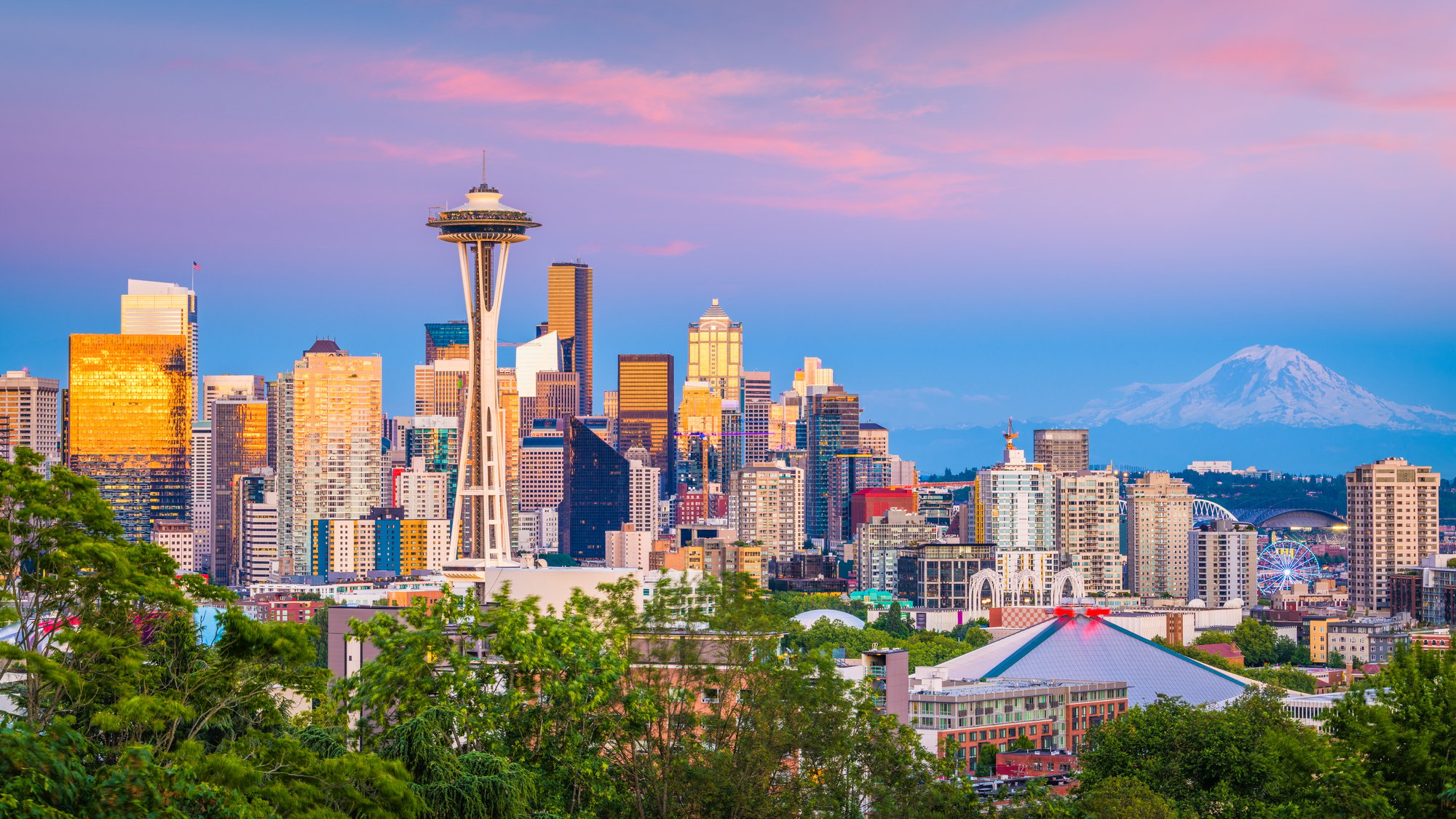City planning efforts for the University District envision more density around a future light-rail station and buildings up to 34 stories high.
By Lynn Thompson
Seattle Times staff reporter
On a recent cold and sunny afternoon, a young man in bluejeans and dreadlocks strummed a guitar outside the University District post office. It might have been 1973 or 1993. There’s a sameness to the street scene over time here — youthful energy, a creative spirit, the ongoing tension between counterculture and conformity.
But “The Ave” has struggled in recent decades. Much of the retail business shifted long ago to University Village, a long walk and a world away. Narrow storefronts featuring budget teriyaki and pho proliferated. More homeless street kids and drug dealers moved in.
Doug Campbell, who’s run Bulldog News since 1983, describes the experience of walking the street today as abrasive.
“The Ave has seriously declined as a business district. It shouldn’t be that way,” he said.
Now, with construction of a new Sound Transit light-rail station at Northeast 43rd Street and Brooklyn Avenue Northeast set to begin next month, city planners and community leaders are trying to guide new development along The Ave and the surrounding neighborhood.
Through two years of meetings and workshops, they’ve reached a surprising amount of agreement: Keep the funky, eclectic character. Add several thousand new residents, along with parks and a school to attract families. Build residential and office towers in the heart of the district as high as 340 feet.
With the University of Washington taking an active role in the planning, neighborhood advocates have identified other shared goals: Attract youth-oriented businesses including shops, night life, art galleries and music venues. Provide social services to residents in need. Become an innovation center attracting spinoff businesses from the UW so the U District resembles not just Berkeley, but also Palo Alto and Cambridge.
“In my career, I’ve never seen such a clear consensus about strategic growth,” said Brian Scott, an urban planner and the project manager for the University Livability Partnership, the planning effort sponsored by the city, the UW, the University District Chamber of Commerce and its Business Improvement District. “Clearly people want to see the U District grow and evolve.”
Open-space issue
The biggest source of disagreement so far hasn’t been about height and increased density, which many feel is necessary to attract more full-time residents, but about open space. The UW paid $4.6 million for the right to develop above the light-rail station that’s scheduled to open in 2021.
University officials say they haven’t yet determined what they will do with the nearly block-long site on Brooklyn, behind the Neptune Theatre and across the street from UW Tower, formerly Safeco Tower. Officials say they favor adding housing, including some that might be subsidized so young faculty members or professional staff can afford to live nearby.
But they also say they need additional office space.
“The UW Tower is full. There’s not a lot to rent in the district. But it’s not just the UW who might want space. We want a diversity of employers who want to locate next to a major research institution,” said Theresa Doherty, director of regional and community relations for the university.
“We have a key stake in the U District being safe, with a mix of shops and more innovative things happening,” she said.
Some neighborhood activists, including former City Councilmember Peter Steinbrueck, who lives in nearby Ravenna, don’t want to see another office tower dominating the station site.
They are advocating for a public plaza above the future light-rail stop to serve as a gathering place for some of the estimated 14,000 commuters and students who will travel daily to and from the district by rail. The plaza also could host a relocated University District Farmers Market, one of the district’s most popular draws, or a midweek satellite market.
“If it’s an office tower, it will only be active during the day. It will be dead at night and on the weekends,” said Cory Crocker, a resident and small-business owner. Alternately, he suggests, the city could create a public space by acquiring the four corner parcels at University Way Northeast and Northeast 43rd Street, another heavily traveled intersection.
Campbell, of Bulldog News, notes that an upzone has the potential to create a lot of wealth for property owners.
“For the neighborhood to recapture some of that wealth in the form of open space seems like a reasonable proposal,” he said.
Others involved in the planning process see several problems with the proposals.
“Cory’s group has identified three different locations for open space, none of which they control,” said Scott, the partnership project manager. The partnership plans to host a series of community meetings on open space in the coming months, he said.
Some of those who actually do control some of the property think more public space will produce more problems — loitering, drug sales, homeless campers.
“The existing urban public parks and spaces in Seattle are centers for crime and anti-social behavior and have been for some time. To think that building another urban open space will somehow avoid those problems, which the city has been unable/unwilling to deal with, is absurd,” said Scott Soules, a past president of the University District Chamber of Commerce, Business Improvement Area and Parking Associates, which owns several parking lots in the neighborhood with development potential.
UW’s role praised
The UW has gotten high marks for its participation in the planning process. Many of the partnership members noted that university officials have historically not been engaged in the neighborhood. The word “gorilla” (as in 800-pound) was the common description of the university’s past relationship to the neighborhood.
But UW President Michael Young arrived in 2011 with the idea that the university could be more entrepreneurial and spin off new businesses or research-and-development companies that could locate nearby. He also told staff that the university could be a better neighbor than it had been in the past.
The city under Mayor Mike McGinn also was praised for bringing a half-dozen different departments to the partnership discussions, including the Office of Economic Development, the Department of Planning and Development, the police, the Department of Transportation and the Department of Neighborhoods.
Barbara Quinn, who has lived for almost 40 years in University Park, the neighborhood north of the UW and Greek Row, said the city, like the university, has more often been an adversary than an ally. She’s fought illegal rooming houses, cars parked in yards, noisy drunken parties and absentee landlords, and has feared the neighborhood would be “swallowed whole” by development.
Now she feels like all the major players are working toward the same vision of adding housing and families, new stores and a school. The UW, she said, is talking about some new development along 15th Avenue Northeast that would face the neighborhood. Property owners are talking about the possibility of housing on the opposite side of 15th that would overlook the campus, making less of a wall between the two.
Still, Quinn, whose children went to the former University Heights Elementary School that was closed in 1989 because of declining enrollment, worries that the city will rezone for greater height and density but not provide the amenities like parks, attractive pedestrian routes and a new school.
“We could get all of the bad stuff and none of the good stuff,” she said.
Other community advocates worry about the right mix of market rate and affordable housing, of upscale new development and social services to meet some of the district’s chronic needs.
On a recent Friday afternoon, volunteers including students from the UW prepared a meal at Roots, a homeless shelter for young people that operates in the basement of the University Temple United Methodist Church.
Roots Executive Director Kristine Cunningham noted that many homeless young people who pass through the neighborhood don’t look much different from the students in backpacks and bluejeans walking up and down The Ave. Last year, she said, more than 500 young people came through the shelter’s doors.
No matter how much new development is attracted over the coming years, she said, the U District will still have homeless youth, some only temporarily stranded and awaiting financial aid or a vacant room, others aging out of foster care or escaping abusive families, and who are vulnerable to addiction and predation.
And no matter how extensive the revitalization effort now under way, Cunningham said, “there will still be college kids wanting to buy drugs on The Ave.”
She also worries that developers incentivized by taller building heights will build only market-rate condos and apartments that displace the many students and lower-income people who call the district home.
“There’s amazing diversity here. You can get more international food here than anywhere else in the city. There are incredible cultural and academic opportunities because of the UW. It would be wonderful if we could showcase that without being afraid of our gritty side.”
Lynn Thompson: lthompson@seattletimes.com or 206-464-8305. On Twitter @lthompsontimes









